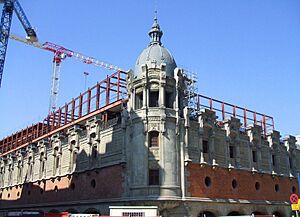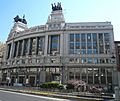Ricardo Bastida facts for kids
Quick facts for kids
Ricardo Bastida
|
|
|---|---|
| Born | 15 August 1879 |
| Died | 15 October 1953 (aged 74) |
| Nationality | Spanish |
| Occupation | Architect |
| Spouse(s) |
Rosario Lecea
(m. 1813–1853) |
| Children | 8 |
| Buildings | Alhóndiga Bilbao, Bilbao Banco de Bilbao, Madrid Puente de Deusto, Bilbao Casa Cuna, Bilbao Casa Lezama-Leguizamon, Bilbao |
Ricardo Bastida was a famous Basque architect from Spain. He was born in Bilbao on August 15, 1879, and passed away there on October 15, 1953. Ricardo Bastida designed many important buildings in Bilbao and Madrid. He also had a big idea in 1923 to expand the city of Bilbao, which helped it grow into the large city it is today.
Contents
Early Life and Learning
Ricardo Bastida was born in a main neighborhood of Bilbao. His father, Luis de Bastida y Azcuenaga, was a math teacher. His mother, Josefa Bilbao Landazuri, was a primary school teacher. Ricardo was one of six children.
Because his parents were well-educated, learning was very important in the Bastida family. Ricardo was great at drawing and math. He trusted his father to help him make big decisions, like choosing his career. He went to public schools in Achuri and a secondary school where he met the famous painter Aurelio Arteta. They became close friends.
Ricardo Bastida's Career
Ricardo Bastida's career as an architect was long and successful. He worked on many important projects that shaped the cities of Bilbao and Madrid.
Becoming an Architect
- 1895-1901: In 1895, Ricardo finished high school with great grades in both arts and sciences. That same year, he started studying at the School of Architecture in Barcelona. This is also when he began his love for photography. He even developed his own photos in a small lab at home.
- 1902-1904: At 22, Ricardo finished his architecture studies and returned to Bilbao. He was very excited to join the studio of Severino de Achucarro, a well-known architect. In 1903, he started working for the city of Bilbao as Achucarro's assistant. Ricardo Bastida worked with the Bilbao city administration for 50 years! In 1904, the city council held a contest to plan a new expansion for Bilbao. Ricardo and Pedro Guimón worked together on a proposal. Ricardo also started teaching at the School of Arts and Crafts in Bilbao.
Designing Public Buildings
- 1905-1906: The city asked Bastida to design several public buildings. In 1905, he traveled to different European cities like Hamburg, Paris, and Brussels to study their designs. When he came back, he designed the "Alhóndiga Municipal de Bilbao", which was a large warehouse. He also designed public laundries and a street called "Calle Castaños". These buildings showed his modern style. Even though travel was expensive, Bastida traveled a lot for the city. This helped him learn a lot by visiting museums, factories, and hospitals in many places.
- 1907: Bastida became the Chief Architect of Civil Construction for the City of Bilbao. He held this important job until 1927. During this time, he planned many big projects, though not all of them were built. He designed the "Parque del Ensanche" (a park) with engineer Juan Eguiraun.
Family Life and New Projects
- 1908-1910: Ricardo was still living with his parents and siblings. He designed a house in Ondarroa, a village in Biscay. Years later, this house became his own summer home. In 1909, the "Alhondiga Municipal de Bilbao" opened. As Bilbao grew, people started thinking about holding an International Exhibition there.
- 1911: Bastida became the assistant director of the School of Arts and Crafts and Foremen. He gave talks about art history there. During a summer trip to Ondarroa, he met Rosario Lecea, who later became his wife. She was born in Manila, Philippines, and lived in Ondarroa.
- 1912-1915: Ricardo traveled to Europe again for work, visiting art schools in places like Geneva and Florence. He also studied plans for the "Parque del Ensanche." On January 8, 1913, Ricardo Bastida and Rosario Lecea got married. They went on their honeymoon to Paris, Rome, and other Italian cities. They settled in Bilbao and had eight children: Ricardo, Juan Luis, Rosario, Jose María, María Victoria, Eloisa, Carmen, and Teresa. In 1914, Bastida designed the "Casa Cuna de San Antonio" (a children's home). In 1915, he designed new schools in Indautxu to help with the growing number of students in Bilbao.
More Buildings and Hobbies
- 1916-1920: In 1916, Indalecio Prieto Tuero became a city council member. Even though Bastida and Prieto had different political ideas, they became good friends. They respected each other and both wanted to make society better. In 1919, Bastida designed a branch of the "Banco de Bilbao" bank in Madrid.
- 1921-1922: Ricardo's friend, Aurelio Arteta, painted beautiful scenes of Basque village festivals on three walls of the Ondarroa house. These paintings were later given to the "Museo de Bellas Artes de Bilbao" in 1963. Ricardo's hobbies included cinema and photography. He didn't have much free time, but he loved walking everywhere in Bilbao. In Ondarroa, he would walk to nearby towns with his children. He also enjoyed rowing and swimming at the beach. In 1922, he finished building "Torre Urizar" and the main office of "Banco de Bilbao" in Madrid. He became the architect for the bank, a job he kept until he passed away.

City Planning and Bridges
- 1925-1926: In March, Ricardo presented plans for connecting Bilbao with nearby towns. He also suggested putting all train and bus lines in one station in Abando. In 1926, he took part in a global competition to plan the expansion of Bilbao. He also went on a trip to the U.S. with his oldest son, visiting cities like New York, Chicago, and Detroit.
- 1927-1928: He presented two ideas for the "Puente de Begoña" (Begoña Bridge). One was a movable bridge, and the other was fixed. He also planned movable bridges to connect Abando and Deusto, allowing ships to pass. However, these bridges were very expensive.
- 1929-1932: Ricardo continued building houses in Ondategi. He designed about twenty houses in Getxo. In April 1932, construction began on the "Puente de Deusto".
War and Reconstruction
- 1936-1937: The movable Deusto and City Hall bridges finally connected both sides of the river. But during the Spanish Civil War, these bridges were ordered to be destroyed. Sadly, on September 15, Ricardo's oldest son, also named Ricardo, who was studying architecture, died in the war. Two days later, his funeral was held in Bilbao. Years later, the new mayor asked Bastida to rebuild the movable bridges.
- 1938-1939: He worked on improving and expanding the Santa Maria tuberculosis sanatorium in Bilbao. He did not charge for this work, or for other religious or charity projects. Because of the war, Bastida faced some difficulties due to his friendship with Prieto. He was not put in prison, but his job was paused without pay. Luckily, the issues were cleared up, and Ricardo, being a kind person, forgave those who had made accusations. After the civil war, Ricardo Bastida was 59 years old. Despite the challenges, he started his career again with great energy.
Later Years and Legacy
- 1940-1943: In 1941, he planned another sanatorium in Santa Marina, this time for children with tuberculosis. He also designed the "Estación Central de Autobuses" (Central Bus Station) in Bilbao. A year later, he planned social homes with Emiliano Amann. In 1943, he built the "Iglesia del Buen Pastor" (Good Shepherd Church) in Lutxana.
- 1947-1950: By this time, two of his sons were married. The family still spent summers in Ondarroa. His grandchildren became his new companions on walks and subjects for his photos and films. Ricardo Bastida was a cheerful and friendly person. He continued his hobbies until the very end.
- 1951-1953: In 1951, he was part of the group that judged the contest to redesign San Mames Stadium, home of Athletic Club de Bilbao. In 1952, Bastida began remodeling the main office of "Banco de Bilbao" on Gran Vía. In the summer of 1953, he decided to visit his friend Prieto in Mexico, who was not well. Ricardo became ill on the plane and had to cancel his plans. Prieto took care of him. A few days later, Ricardo felt stronger and returned to Bilbao. He had surgery but passed away soon after, on October 15, 1953, at 74 years old. Prieto wrote an article in his memory, saying, "Mr. Bastida is one of the most distinguished Spanish architects and certainly one of the best men I have ever known." Ricardo was a humble person. Before he died, he asked his family to write only "Ricardo Bastida, Diocesan Architect" on his obituary, without adding any fancy titles.
Main Works
Ricardo Bastida designed many important buildings and plans, including:
- Alhóndiga, Bilbao, 1909
- "Casa Cuna" (Children's Home), 1914
- Municipal Center of Disinfections, 1916
- "Casa Lezama-Leguizamon", Bilbao, 1921
- "Banco de Bilbao" bank, at 16 C. Alcalá in Madrid, 1923
- Blueprint for connecting Bilbao with its surrounding villages, 1923
- The entry plan to Bilbao from Begoña, 1925
Images for kids
See also
 In Spanish: Ricardo de Bastida para niños
In Spanish: Ricardo de Bastida para niños
- Modernism in the architecture of Bilbao
- Alhóndiga Bilbao Official Site: http://www.alhondigabilbao.com/
- Ricardo Bastida on Euskomedia




